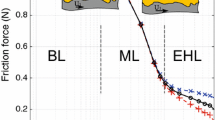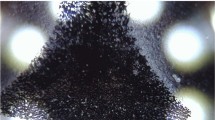Abstract
This paper presents a numerical analysis of the hydrodynamic pressure build-up between parallel surfaces. According to the Reynolds theory, it is not possible to generate a pressure between flat parallel sliding surfaces. However, experimental results demonstrate that mechanical seal surfaces can be separated by a full fluid film if the sliding speed is high enough. Several theories, including the roughness effect, have been proposed to explain this unexpected lift-off. A real demonstration of the roughness induced pressure generation has only recently been made possible with the development of deterministic mixed lubrication models. It is demonstrated that a transverse pumping mechanism that varies from place to place with the surface topography can explain the pressure build-up. A simplified model is proposed to include the transverse pumping and to simulate the roughness induced pressure generation.




















Similar content being viewed by others

References
Adjemout, M., Brunetiere, N., Bouyer, J.: Numerical analysis of the texture effect on the hydrodynamic performance of a mechanical seal. Surf. Topogr.: Metrol. Prop. 4(1), 014002 (2016). https://doi.org/10.1088/2051-672X/4/1/014002
Ayadi, K., Brunetière, N., Tournerie, B., Maoui, A.: Experimental and numerical study of the lubrication regimes of a liquid mechanical seal. Tribol. Int. 92, 96–108 (2015). https://doi.org/10.1016/j.triboint.2015.05.022
Bayada, G., Faure, J.: A double scale analysis approach of the reynolds roughness—comments and application to the journal bearing. J. Tribol. 111(2), 323–330 (1989)
Bayada, G., Martin, S., Vasquez, C.: An average flow model of the reynolds roughness including a mass-flow preserving cavitation model. J. Tribol. 127(4), 797–802 (2005)
Brunetière, N., Tournerie, B., Minet, C.: On the roughness induced hydrodynamic pressure in mechanical face seals. In: 21st International Conference on Fluid Sealing, pp. 103–113. BHRGroup, Milton Keynes (2011)
Denny, D.: Some measurements of fluid pressures between plane parallel thrust surfaces with special reference to radial-face seals. Wear 4, 64–83 (1961)
Flitney, R., Nau, B.: Performance testing of mechanical seals. In: Nau, B. (ed.) 13th International Conference on Fluid Sealing, pp. 441–466. BHR Group, Kluwer Academic Publishers, Brugge (1992)
Francisco, A., Brunetière, N.: A hybrid method for fast and efficient rough surface generation. J. Eng. Tribol. J 230(7), 747–768 (2016). https://doi.org/10.1177/1350650115612116
Greenwood, J.A., Williamson, J.B.P.: Contact of nominally flat surfaces. Proc. R. Soc. (Lond.) A295, 300–319 (1966)
Gropper, D., Wang, L., Harvey, T.J.: Hydrodynamic lubrication of textured surfaces: a review of modeling techniques and key findings. Tribol. Int. 94, 509–529 (2016). https://doi.org/10.1016/j.triboint.2015.10.009
Hamilton, D., Walowit, J., Allen, C.: A theory of lubrication by micro-irregularities. J. Basic Eng. 88, 177–185 (1966)
Hamrock, B., Dowson, D.: Ball Bearing Lubrication—The Elastohydrodynamics of Elliptical Contacts, p. 047103553X. Wiley, New York (1981)
Harp, S., Salant, R.: An average flow model of rough surface lubrication with inter-asperity cavitation. J. Tribol. 123(1), 134–143 (2001)
Hill, I., Hill, R., Holder, R.: Fitting johnson curves by moments. Appl. Stat. 25, 180–189 (1976)
Hu, Y., Tonder, K.: Simulation of 3-d random rough surface by 2-d digital filter and fourier analysis. Int. J. Mach. Tools Manuf. 32(1/2), 83–90 (1992)
Kane, M., Bou-Saïd, B.: Comparison of homogenization and direct techniques for the treatment of roughness in incompressible lubrication. J. Tribol. 126(4), 733–737 (2004)
Lebeck, A.: Parallel sliding load support in the mixed friction regime. Part 1—the experimental data. J. Tribol. 109(1), 189–195 (1987)
Lebeck, A.: Parallel sliding load support in the mixed friction regime. Part 2—evaluations of the mechanisms. J. Tribol. 109(1), 196–205 (1987)
Lebeck, A.: Principle and Design of Mechanical Face Seals. Wiley, New York (1991)
Lebeck, A.: Mixed lubrication in mechanical face seals with plain faces. J. Eng. Tribol. J 213(J3), 163–175 (1999)
Lubbinge, H.: On the lubrication of mechanical face seals. Ph.D. thesis, University of Twente, Netherlands (1999)
Minet, C., Brunetière, N., Tournerie, B.: A deterministic mixed lubrication model for mechanical seals. J. Tribol. 133(4), 042203 (2011). https://doi.org/10.1115/1.4005068
Minet, C., Brunetière, N., Tournerie, B.: On the lubrication of mechanical seals with rough surfaces: a parametric study. J. Eng. Tribol. J 226(12), 1109–1126 (2012)
Nau, B.: Hydrodynamic lubrication in face seals. In: BHRA, (ed.) 3rd International Conference on Fluid Sealing, Paper E5, pp. 73–120. BHRA, Cambridge (1967)
Nau, B.S.: Hydrodynamics in face seal films. In: 2nd International Conference on Fluid Sealing, paper F5, pp. 61–80. BHRA, Cranfield, England (1964)
Nyemeck, A., Brunetière, N., Tournerie, B.: A multiscale approach to the mixed lubrication regime: application to mechanical seals. Tribol. Lett. 47(3), 417–429 (2012)
Pape, J.: Fundamental research on a radial face seal. ASLE Trans. 11(4), 302–309 (1968)
Patir, N., Cheng, H.: An average flow model for determining effects of three-dimensional roughness on partial hydrodynamic lubrication. J. Lubr. Technol. 100(1), 12–17 (1978)
Patir, N., Cheng, H.: Application of average flow model to lubrication between rough sliding surfaces. J. Lubr. Technol. 101(2), 220–230 (1979)
Reynolds, O.: On the theory of lubrication and its application to mr. beauchamp tower’s experiments, including an experimental determination of the viscosity of olive oil. Philos. Trans. R. Soc. Lond. 177, 157–234 (1886)
So, H., Chen, C.: Effects of micro-wedges formed between parallel surfaces on mixed lubrication—part i: experimental evidence. Tribol. Lett. 17(3), 513–520 (2004). https://doi.org/10.1023/B:TRIL.0000044499.67099.74
So, H., Chen, C.: Effects of micro-wedges formed between parallel surfaces on mixed lubrication—part ii: modeling. Tribol. Lett. 19(2), 83–91 (2005). https://doi.org/10.1007/s11249-005-5083-6
Summers-Smith, D.: Laboratory investigation of the performance of a radial face seal. In: BHRA, (ed.) 1st International Conference on Fluid Sealing, Paper D1. BHRA, Ashford, UK (1961)
Tripp, J.: Surface roughness effects in hydrodynamic lubrication: the flow factor method. J. Lubr. Technol. 105(3), 458–465 (1983)
Vezjak, A., Vizintin, J.: Experimental study on the relationship between lubrication regime and the performance of mechanical seals. Lubr. Eng. 57(1), 17–22 (2001)
Watson, W., Spedding, T.: The time series modelling of non-gaussian engineering processes. Wear 83, 215–231 (1982)
Author information
Authors and Affiliations
Corresponding author
Rights and permissions
About this article
Cite this article
Brunetière, N., Francisco, A. Lubrication Mechanisms Between Parallel Rough Surfaces. Tribol Lett 67, 116 (2019). https://doi.org/10.1007/s11249-019-1228-x
Received:
Accepted:
Published:
DOI: https://doi.org/10.1007/s11249-019-1228-x



